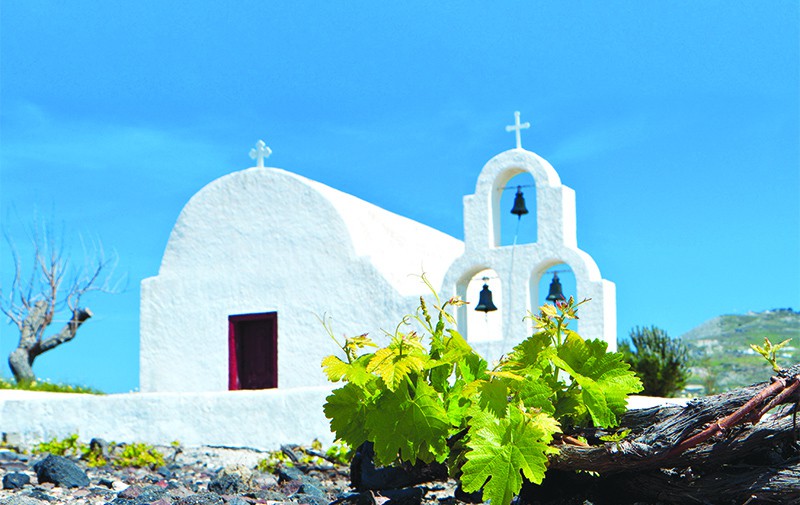
The Greeks may well have as many cheeses as they have wines—and they are said to have more than two hundred indigenous grape varieties. Unfortunately for the turophile, the vast majority of Greek cheeses never leave the islands and mountain towns in which they are made. Thankfully, Greek wines do, giving us plenty of opportunities to experiment while we wait for the cheese scene to catch up.
What’s more, Greek wines tend pair terrifically with cheeses, as they’ve both grown up together: Cheese is an integral part of the Greek diet, layered into phyllo pies and crumbled on top of salads; cooked in casseroles and cubed for mid-afternoon snacks. There’s not a wine tasting in Greece that goes on without a small plate of cheese, for even in the professional wine tasting world, it’s unheard of not to at least be offered something to eat. So as you might expect, Greek winemakers tend to make wines to enjoy alongside food, favoring finesse over gobs of mouth-coating fruit and oak. The wines tend toward savory, even umami, flavors. Most aren’t laden with oak, and many have cheese-loving acidity.
The most versatile cheese wines could be the whites from Santorini. The island’s wines are based mainly on assyrtiko, a grape with an uncanny ability to hold on to its acidity despite Santorini’s never-flagging sun and heat. The island makes powerful wines, as firm and savory as the volcanic tufa the vines grow on, and as bright and clear as the air, with a palate-whetting hint of salinity. When young, these wines can play off a fresh goat cheese as well as they can slice through a grilled halloumi. As they age they turn nutty and broad, a sort of poor-man’s Chassagne-Montrachet to go with an Epoisses or Comté.
Malagousia (mah-lah-goozee-AH) falls at the other end of the spectrum. It’s the “it” grape of the moment in Greece, though it was on the verge of extinction when Evangelos Gerovassiliou discovered it in the 1970s. The wine he makes from it is one of Greece’s best, a silken white that tastes of ripe peaches and sea mist. It’s sunny and saline, although too rich for feta; it needs a cheese with both some tang and lots of milky richness, like a robiola with a good amount of goat’s and sheep’s milk blended in.
For reds there’s Nemea, an area of the Peloponnese focused on agiorgitiko (ah-YEE-or- YEE-tee-koh), a grape that makes everything from juicy rosés to spicy, dark-berried bottlings that can withstand aging. The rosés provide the perfect foil to feta’s salty tang and pair with fresh goat cheeses just as well; the deeper, denser pleasures of a classic Nemea require something with a bit more tooth: think butternut-y aged cheeses, such as aged cheddars and Mimolette.
And then there’s Náoussa, Greece’s answer to Italy’s Barolo, grown in the country’s far north. Xinomavro (ksee-NOH-mah-vro), the local grape, doesn’t produce wines with much color, but it packs a bewitching scent—imagine the aroma of a forest after a rainstorm—and a palatesticking combination of cherry flavors and drying tannins. Look to Italy’s Piedmont for cheese inspiration; then, as you eat your taleggio, rejoice in the fact that you’ve saved yourself $30 or more by going Greek.
If you’re looking for a sweet way to conclude a meal, consider a deep golden muscat from the island of Samos. The wine’s floral, deeply fruity flavors are like a drizzle of honey over Manouri, a downy-soft sheep’s milk cheese that’s creamy enough to stand in for dessert. Muscat also makes a sweet counterpoint to the salty dryness of a graviera.
If you have a soft spot for Retsina, as I do, then you are in luck, as the recent drive toward making world-class wines has forced Retsina producers to up their game, too. Using high-quality grapes and a restrained amount of high-quality resin, retsina producers are creating a wine that’s as refreshing as a cool breeze blowing through a stand of pines by the beach. There’s no better match for a chunk of briny feta doused in olive oil and showered in fresh oregano leaves.
WINES TO TRY
Santorini Sigalas 2011 Santorini ($24; Diamond Importers, Chicago, IL)
Malagousia Gerovassiliou 2011 Epanomi Single Vineyard Malagousia ($25; Cava Spiliadis, Astoria, NY)
Nemea Domaine Skouras 2010 Nemea St. George ($15; Diamond Importers, Chicago, IL)
Naoussa Boutari 2008 Náoussa ($19; Terlato Wines International, Lake Bluff, IL)
Sweet Wine Union of Winemaking Cooperatives of Samos 2010 Samos Vin Doux Naturel ($13; Athenee Importers & Distributors, Hempstead, NY)
Retsina Gaia Retsina Ritinitis Nobilis ($15; Athenee Importers & Distributors, Hempstead, NY)






